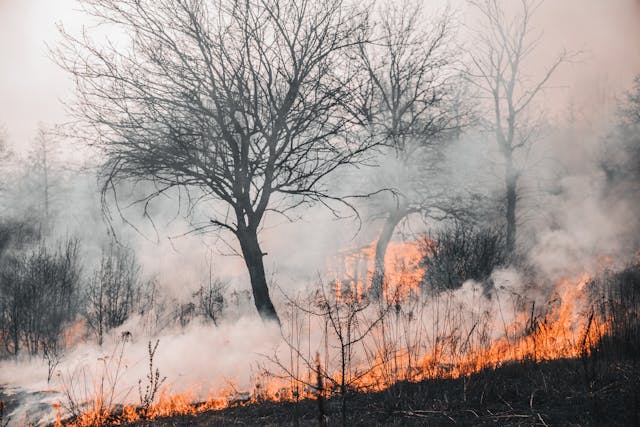
How do fires regenerate forests? Fires can regenerate a forest because they clear the thick canopy, they release nutrients into the soil, and they can trigger the dispersal of seeds from a lot of trees.
As forests grow, they naturally get thicker and taller. Trees need sunlight and leaves to photosynthesize. If a tree cannot get much sunlight, then it will need larger leaves. To cope in a forest, trees either need to grow taller or sprout more and larger leaves. However, both of these come with problems. If trees grow taller, they become more unstable and they are more prone to damage. They have less protection from the wind. They also need to be able to pump fluids and nutrients the vast distances from their roots to their leaves. And if trees grow more leaves, they need the energy reserves to be able to grow them. And more leaves can mean more chance of wind damage and they need more and longer branches. And whether trees become taller or grow more leaves, they are always in competition with other trees that are growing taller or growing more leaves. The net result of this is that the canopy of a forest becomes very high and very thick. Not much light can penetrate to the forest floor, and the only plants that can grow lower down are plants that don’t need a lot of sunlight. You get a lot of things like fungi that have evolved to live in dark places. If left alone, the canopy will get thicker and thicker, and the forest will potentially stagnate.
Forest fires are a natural part of the ecosystem cycle. Fire will sweep through a forest and burn down all of the trees and plants, clearing a large area. The animals there will either die or flee. The forest fire is technically a reset for the area. Once the trees have gone and the area has been cleared, the pioneer species move in. These are microorganisms and plants that can live in difficult areas. These plants come in on the wind, and they start to grow where they settle. The forest fire significantly affects the soil because ash from the burned trees and vegetation mixes into the soil. Ash brings minerals and nutrients into the soil, but it also raises the pH of the soil, making it less acidic. This is not good for trees and plants, but it is good for bacteria, microorganisms, and these pioneer plants. The pioneer plants and bacteria are usually carried in on the wind as spores, and they grow where they settle. If the burned area is large, it can take a long time for the pioneer species to get across it.
The pioneer plants feed on the nutrients in the soil, and they lower the pH back to normal while creating a richer and more fertile topsoil. Once the soil can sustain them, the shrubs, bushes, and smaller plants move back in. They need a lot of sunlight and grow very quickly. You don’t usually find them in a fully grown forest because the tree canopy blocks out the sunlight. They are usually found on the periphery of a forest. Once these plants have started to grow, some of the smaller animals will return, and once they are there, the predators will return as well. The ecosystem will slowly return to normal. These animals will carry seeds in from other areas, and soon, trees will start growing again. It will take many years, but the forest will slowly return to the way it was before the fire. And then the process will repeat itself.
There are some trees that are dependent on this cycle of fire to spread their seeds. These trees are called pyrophytes (pyro means fire and phile means love). The fire clears the ground for them to lay their seeds, and their seeds need a certain temperature to start germinating. The seeds will lie on the ground for years before there is a fire and they can start to grow. There are also some trees that are resistant to fire. These trees have thick bark or a lot of moisture in their trunk. Because they can resist fire, they have a competitive advantage.
Fire and regrowth are a cycle that will always continue. The problem with climate change is that forest fires are becoming more common and they are becoming bigger. If they are too large, the pioneer species can’t get far enough into them to begin the regrowth phase, and if they happen too often, the forests will never be able to fully reform. And this is what I learned today.
Sources
https://arctic-council.org/news/how-northern-forests-adapt-to-wildfire
https://www.reforestaction.com/en/magazine/forest-revival-after-fire-and-impact-climate-change
https://www.seattletimes.com/pacific-nw-magazine/sept-20-grow
https://wfca.com/wildfire-articles/wildfire-affect-soil-vegetation
Photo by Vladyslav Dukhin: https://www.pexels.com/photo/forest-fire-4070727/

Pingback: What is a steppe?